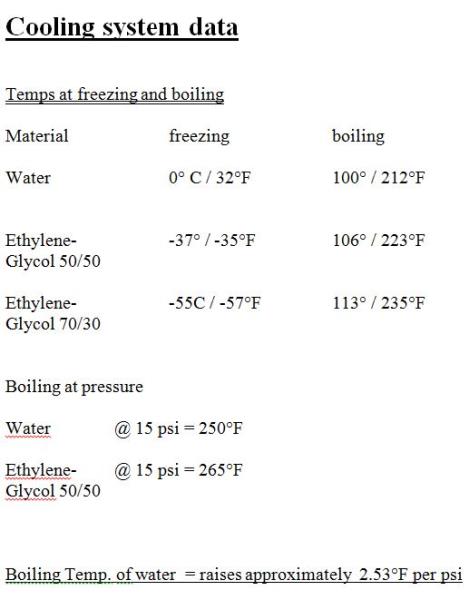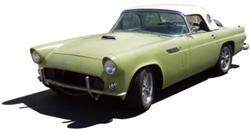|
Author
|
Message
|
|
GREENBIRD56
|
|
|
Group: Forum Members
Last Active: Last Year
Posts: 1.7K,
Visits: 102.7K
|
Water boiling temp raises about 2.5º per psi - its a little more for the anti-freeze mixtures, so that is a good minimum estimate.  When designing a system to avoid a boil-over, the automotive world has used both chemistry and pressure to do the job. Here in Tucson I went to a shop that specializes in desert pick-ups and had them rebuild the T-bird rad. Easily runs the 15# cap - and I run ethylene-glycol to get the chemical edge as well. My guess is that when Ford engineering had a relatively big truck radiator to work with - the pressure cap could be safely reduced. The T-bird rad is about 2/3 the size of a sedan and needs all the "edge" it can get.

Steve Metzger Tucson, Arizona
|
|
|
|
|
Shaggy
|
|
|
Group: Forum Members
Last Active: 7 Years Ago
Posts: 123,
Visits: 609
|
On stuff i build i tend to run a low temp thermostat so for me it doesnt matter as much about pressure is my opinion. I do run a low pressure cap to be safe. As to why i usually run a low temp thermostat, i usually have issues with too much compression and i am trying to limit detonation. Like the 327 in my other daily, if i run r45s's plugs instead of r45's it actually blows the porcelin off them from detontaton. (i do have piston clearance)
|
|
|
|
|
DANIEL TINDER
|
|
|
Group: Forum Members
Last Active: Last Month
Posts: 1.7K,
Visits: 154.2K
|
Aside from antique/original radiators, another reason to avoid the standard 15# cap is deteriorating orig. steel head gaskets (mine started leaking after a thermostat failure overheated the motor). 80% propelene with a modified zero-pressure cap solved the problem. While an open cooling system DOES present corrosion issues, I have a spare stroker engine & aluminum radiator waiting in the wings that I have long been anxious to install. But, a modified water pump impeller & 6-blade fan (along with avoiding heavy city traffic in hot weather) has kept the original shortblock & radiator (125K mi.) running along just fine for nearly 15 years like this with very little added coolant. Heater still works great, and temp gauge never goes above centerline. Car runs like a scalded cat & I thrash the motor regularly like a wealthy teenager Go figure.
6 VOLTS/POS. GRD. NW INDIANA
|
|
|
|
|
tarheel
|
|
|
Group: Forum Members
Last Active: 6 Years Ago
Posts: 36,
Visits: 613
|
It seems to me that if you are worried about pressure and temperature that you might want to look at a waterless coolant. The Evans ads say that since the boiling point of their coolant is very high (in the 340 to 350 degree range - if I remember correctly) boiling is not an issue, and rusting is not an issue since their coolant has no water or other materials that cause it. It also protects against freezing to something like 40 below. They promote it as a lifetime coolant that never needs to be replaced. It is a little expensive, but if your cooling system is in good shape and you plan to keep your car for sometime, it could be cheaper that antifreeze over the long run. I have never used it so I'm not speaking from experience, but I've got a new radiator on order and I will use it when I put it in.
Larry
|
|
|
|
|
56_Fairlane
|
|
|
Group: Forum Members
Last Active: 9 Months Ago
Posts: 575,
Visits: 14.6K
|
About 20 years ago I was driving my 63 F100 with 292 home from a long period of storage. I had gone through everything for the trip but I might have neglected using the right radiator cap. About 40 miles into the 60 mile trip, the radiator upper tank broke a seam. I had an extra 5 gallons of water with me and that almost didn't get me the rest of the trip. It was bone dry at the end of the trip. Luckily the engine didn't suffer any damage from overheating.
The radiator was original and the cooling system had sat completely dry for 15 or so years prior. I'm sure the radiator cap was a 12-15# and the pressure blew the radiator. It had no heater core.
~DJ~ AKA "Bleach"
1956 Ford Fairlane Town Sedan 30K original miles
|
|
|
|
|
DryLakesRacer
|
|
|
Group: Forum Members
Last Active: 2 days ago
Posts: 1.7K,
Visits: 340.1K
|
I run a #7 on my 56 292. No recovery system and 1" low in the tank. Mustang 5-1/4" water pump pulley, a plugged bypass hose with 1/8" hole in it and a 4 blade fan with no problems in SoCal.
56 Vic, B'Ville 200 MPH Club Member, So Cal.
|
|
|
|
|
Dobie
|
|
|
Group: Forum Members
Last Active: 2 Years Ago
Posts: 476,
Visits: 22.0K
|
It may have had something to do with the fact that the 'Birds tend to run hotter because of the tighter engine compartment and more restricted air flow through the rad. Also they got beat on more than the trucks. Higher cap pressure would provide an extra margin of safety in those situations.
|
|
|
|
|
Tedster
|
|
|
Group: Forum Members
Last Active: 3 Years Ago
Posts: 513,
Visits: 153.3K
|
It gets complicated, because effective cooling is based on the relative difference between the radiator temperature and ambient temperature.
I just wondered why say, a 57 T Bird with 292 shipped with a 13 pound cap and the trucks with a 292 shipped with a 7 pound cap. Radiator design?
|
|
|
|
|
DANIEL TINDER
|
|
|
Group: Forum Members
Last Active: Last Month
Posts: 1.7K,
Visits: 154.2K
|
Cap pressure is a compromise between cooling system stress & boiling temp. If you increase engine h.p. but not also cooling efficiency, you need to raise pressure to prevent boiling.
There is some controversy re: whether or not an engine normally runs cooler with lower pressure (mine does), but of course you then sacrifice that higher temp safety cushion for hard running/traffic on hot days.
6 VOLTS/POS. GRD. NW INDIANA
|
|
|
|
|
Tedster
|
|
|
Group: Forum Members
Last Active: 3 Years Ago
Posts: 513,
Visits: 153.3K
|
Looking at specs in the 1950s and 1960s there is of course a steady rise in cooling system pressure from around 4 pounds to 16 pounds. It is often said that even if a newer radiator is used a vintage system may not hold up - heater core for example.
In '64 the trucks used a 7 pound cap, but earlier identically engined cars (sometimes) used a 13 pound cap. What was the determining factor at that time whether a vehicle used different pressure radiator caps? Could it be the coolant - "Permanent" type glycol was a relatively new product, and this choice affected the thermostat selection?
Fast forward today, assuming we could run a higher pressure cap than was used for a given model at the time - do we want to? Is there an advantage to running a higher pressure radiator cap provided it is still within the specs of the radiator or heater core? I ran a 16 pound cap for quite a while until I was advised not to do so, it certainly led to very rigid upper radiator hose as I recall.
|
|
|
|